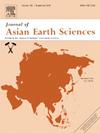Tracing metal sources in orogenic gold deposits of the Timburu Goldfield, Meratus, Indonesia: A geochemical and statistical approach
IF 2.7
3区 地球科学
Q2 GEOSCIENCES, MULTIDISCIPLINARY
引用次数: 0
Abstract
Orogenic gold deposits at the Timburu Goldfield, Indonesia, are primarily hosted by metamorphosed ultramafic and volcanic rocks, as well as quartz lodes formed along shear zones. Gold mineralisation developed along the lithological contacts between serpentinites, porphyritic intrusions, and granitoids. The mineralization is represented by electrum and hessite, with trace amounts of chalcopyrite, galena, tetrahedrite, and Co-Ni-As-S phases. The alteration mineralogy of mafic rocks in Timburu includes magnesite, dolomite, sericite, albite, calcite, and chlorite. This study integrates a multi-statistical evaluation of in-situ trace-element data, geological relationships, and detailed mineralogical characterisation to better understand the evolution of geochemical reservoirs responsible for metal accumulation during orogenic events. Principal component analysis (PCA) produced three significant components that explained 80% of the cumulative variance. We divide the pyrite data into three groups based on trace element correlations, which are likely linked to pyrite texture and paragetic sequences. The results show that the Ni-Co and other metals were leached from metamorphosed ultramafic rocks and mobilised during alteration. Metals, including Au have been released during greenschist- to amphibolite-facies metamorphism in the context of a continent–continent collision. The rare earth element (REE) patterns of metavolcanic and serpentinised ultramafic rocks may be similar to other accretionary complexes formed during continent–continent collision. The transformation of serpentinite to listvenite is controlled by the addition of carbon dioxide and the mobilisation of SiO2, MgO, and CaO. Chemical changes during alteration are primarily dominated by the incorporation of trace elements into pyrite.

求助全文
约1分钟内获得全文
求助全文
来源期刊

Journal of Asian Earth Sciences
地学-地球科学综合
CiteScore
5.90
自引率
10.00%
发文量
324
审稿时长
71 days
期刊介绍:
Journal of Asian Earth Sciences has an open access mirror journal Journal of Asian Earth Sciences: X, sharing the same aims and scope, editorial team, submission system and rigorous peer review.
The Journal of Asian Earth Sciences is an international interdisciplinary journal devoted to all aspects of research related to the solid Earth Sciences of Asia. The Journal publishes high quality, peer-reviewed scientific papers on the regional geology, tectonics, geochemistry and geophysics of Asia. It will be devoted primarily to research papers but short communications relating to new developments of broad interest, reviews and book reviews will also be included. Papers must have international appeal and should present work of more than local significance.
The scope includes deep processes of the Asian continent and its adjacent oceans; seismology and earthquakes; orogeny, magmatism, metamorphism and volcanism; growth, deformation and destruction of the Asian crust; crust-mantle interaction; evolution of life (early life, biostratigraphy, biogeography and mass-extinction); fluids, fluxes and reservoirs of mineral and energy resources; surface processes (weathering, erosion, transport and deposition of sediments) and resulting geomorphology; and the response of the Earth to global climate change as viewed within the Asian continent and surrounding oceans.
 求助内容:
求助内容: 应助结果提醒方式:
应助结果提醒方式:


